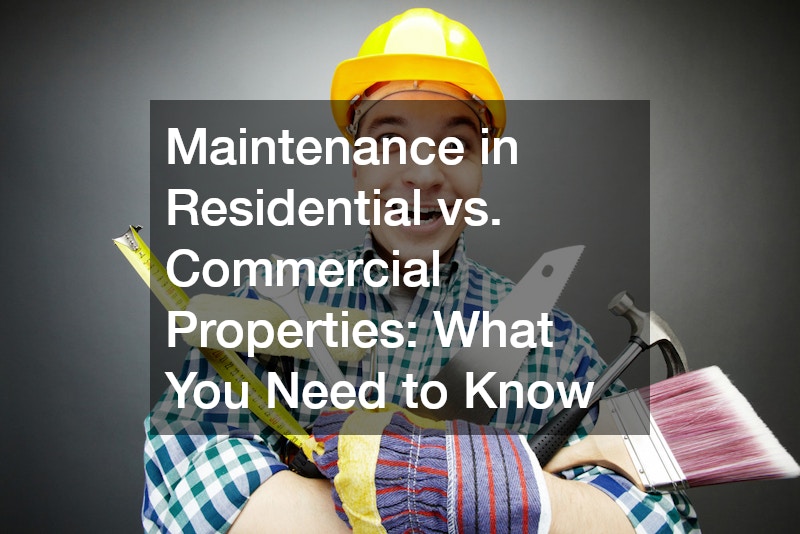Understanding the differences in maintenance between residential and commercial properties is essential for property owners and managers. These differences not only affect the overall maintenance strategy but also have a significant impact on property value over time. In this post, we’ll delve into the unique maintenance needs of each property type and how they can influence both costs and property value.
Residential Property Maintenance
Maintaining residential properties, such as single-family homes or multi-family units, can be a significant financial commitment. Homeowners often face annual maintenance costs ranging from $2,000 to $4,000, which can quickly add up due to the cumulative nature of various expenses.
Routine Maintenance Costs:
Routine maintenance tasks, including plumbing repairs, electrical work, and general upkeep, are necessary to keep residential properties in good condition. These costs often consist of multiple small expenses that can become burdensome over time. Proactive maintenance, such as regular inspections of HVAC systems and roofing, is crucial in preventing small issues from escalating into costly repairs.
Aesthetic and Comfort Considerations:
In residential properties, maintaining aesthetic appeal is essential for tenant satisfaction and retention. Landscaping, interior repairs, and upgrades can enhance the property’s appearance and comfort. Keeping common areas and individual units well-maintained encourages tenants to renew leases, thereby reducing turnover costs.
Commercial Property Maintenance
In contrast to residential properties, commercial properties present a different set of maintenance dynamics. Many maintenance responsibilities are delegated to tenants, especially when it comes to the customization of spaces.
Tenant Responsibilities:
In commercial properties, tenants often take on maintenance responsibilities for any improvements they make. For example, if a tenant installs specialized equipment or fixtures to suit their business needs, they are generally responsible for the upkeep of those additions. This arrangement significantly reduces the landlord’s burden, as they primarily oversee major structural aspects, such as roofing and plumbing, rather than day-to-day maintenance tasks. Effective facilities management plays a crucial role in ensuring that these responsibilities are clearly defined and met, allowing for seamless operations and tenant satisfaction.
Impact of Tenant Improvements:
One of the key benefits of commercial properties is the potential for increased property value through tenant improvements. Enhancements made by tenants—such as modernizing interiors or upgrading facilities—can positively contribute to the overall worth of the property. This not only boosts the property’s appeal to prospective tenants but can also enhance cash flow, making commercial properties an attractive investment.
Key Differences in Maintenance Strategies
While both residential and commercial properties require careful attention to maintenance, their strategies differ significantly due to the nature of each property type.
Frequency of Maintenance:
Residential properties generally require more frequent maintenance due to the higher turnover rate of tenants and the need for ongoing upkeep to guarantee comfort and safety. In contrast, commercial properties may involve less frequent maintenance since tenants are responsible for their customized spaces. This hands-off approach allows landlords to focus on major structural elements while benefiting from improved cash flow.
Budgeting for Maintenance:
When budgeting for maintenance, residential property owners must anticipate routine expenses and potential turnover costs. In contrast, commercial property owners can often predict maintenance expenses more accurately, given that tenants handle many of the fit-out costs and ongoing maintenance for their improvements. This structure leads to a more predictable cash flow, as landlords are less burdened by unexpected maintenance needs.
Expertise and Specialized Knowledge:
Maintaining commercial properties often requires specialized knowledge and skills due to the nature of the businesses occupying the spaces. This can include knowledge of compliance with health and safety regulations or expertise in managing complex HVAC systems. Residential property maintenance, on the other hand, can often be managed by general property management teams or even homeowners themselves.
Comprehensive Maintenance Planning:
Effective maintenance in commercial properties often involves comprehensive planning and strategic oversight. This includes establishing maintenance schedules, tracking repair histories, and implementing preventive measures to minimize potential issues. In contrast, residential maintenance may be more reactive, focusing on immediate repairs rather than long-term planning. By adopting a proactive maintenance approach, commercial property owners can guarantee optimal property conditions and tenant satisfaction.
The Bottom Line
Recognizing the distinct maintenance needs of residential and commercial properties is crucial for property owners and managers. By understanding these differences, owners can allocate resources effectively and implement strategies that maximize property value and tenant satisfaction.
Residential properties necessitate ongoing maintenance to ensure comfort and safety, while commercial properties often provide a more hands-off experience for landlords, allowing them to focus on structural integrity and compliance. By tailoring maintenance approaches to each property type, owners can create environments that foster tenant satisfaction and enhance property value, ultimately leading to successful property management.
.


